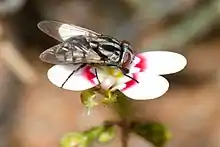Musca vetustissima
Musca vetustissima, commonly known as the Australian bush fly, is a species of fly found in Australia.[1] It is the specific fly that has given rise to the expression "Aussie salute".[2]
| Australian bush fly | |
|---|---|
 | |
| An Australian bush fly on a flower | |
| Scientific classification | |
| Domain: | Eukaryota |
| Kingdom: | Animalia |
| Phylum: | Arthropoda |
| Class: | Insecta |
| Order: | Diptera |
| Family: | Muscidae |
| Tribe: | Muscini |
| Genus: | Musca |
| Species: | M. vetustissima |
| Binomial name | |
| Musca vetustissima Walker, 1849 | |
Description
The Australian bush fly is a dung fly that is closely related to the bazaar fly (M. sorbens). The adults are attracted to large mammals for fluid for nourishment and feces for oviposition.[3] A study showed that there is a low survival rate for eggs and larvae of this species in cattle feces because of infrequent rainfall. The study also showed that parasites and predators have caused a low survival rate.[4] According to a study, the Australian bush fly can spread harmful bacteria. The Australian bush fly can also spread the pathogens Salmonella and Shigella. Most of the bacterial populations per fly occurred in a farm environment, while an urban environment was the lowest.[5] A standard composition that contains small amounts of trimethylamine and indole, blended with large amounts of ammonium sulfate and anchovy meal, attracts the Australian bush fly.[6] A wind-oriented trap has been used to catch this species.[7] The number of ovarioles in females probably have to do with how big they are. If females do not obtain enough dietary protein, the maturation of their eggs will stop.[8] This fly likes to crawl on human faces, as well as on the faces of livestock. It also likes to crawl on human and livestock feces, though it seems that it prefers human feces.[9]
Life cycle
The Australian bush fly breeds in large numbers in dung pads.[10] Larvae have been found in the feces of large mammals. The species continually breeds in subtropical Australia, and migrations help repopulate Australia each spring.[3] In a study, a mixture of levamisole and oxfendazole killed larvae in sheep feces.[11]
See also
References
- "Musca vetustissima, the Australian bush fly". Retrieved 4 April 2009.
- Roger D. Moon (2009). "Muscid flies (Muscidae)". In Gary R. Mullen, Gary Mullen & Lance Durden (ed.). Medical and Veterinary Entomology. Academic Press. pp. 268–288. ISBN 978-0-12-372500-4.
- Richard Mullen, Gary; Mullen, Gary; Durden, Lance (2009). Medical and Veterinary Entomology. Academic Press. p. 276. ISBN 978-0-12-372500-4.
- Matthiessen, J. N. (1985). "Breeding of the bush fly, Musca vetustissima Walker, in an over-wintering area during winter and spring". Austral Ecology. 10 (2): 101–104. doi:10.1111/j.1442-9993.1985.tb00870.x. Archived from the original on 6 January 2013. Retrieved 28 May 2010.
- Vriesekoop, Frank; Shaw, Rachel (7 March 2010). "The Australian bush fly (Musca vetustissima) as a potential vector in the transmission of foodborne pathogens at outdoor eateries". Foodborne Pathog Dis. 7 (3): 275–9. doi:10.1089/fpd.2009.0366. PMID 19895260.
- Mulla, Mir S.; Ridsdill-Smith, James T. (21 June 1985). "Chemical attractants tested against the Australian bush fly Musca vetustissima (Diptera: Muscidae)". Journal of Chemical Ecology. 12 (1): 261–270. doi:10.1007/BF01045609. PMID 24306415.
- Zealand, The Royal Society of New (March 1958). New Zealand Journal of Agricultural Research Mar 1958. The Royal Society of New Zealand. p. 316.
- Vogt, W. G.; Walker, J. M. (July 1987). "Potential and realised fecundity in the bush fly, Musca vetustissima under favourable and unfavourable protein-feeding regimes". Entomologia Experimentalis et Applicata. 44 (2): 115–122. doi:10.1007/BF00367618.
- D. Bowman, Dwight; Georgi, Jay R (2008). Georgis' Parasitology for Veterinarians. Elsevier Health Sciences. p. 17. ISBN 978-1-4160-4412-3.
- DeBach, Paul; Rosen, David (1991). Biological control by natural enemies. CUP Archive. p. 348. ISBN 978-0-521-39191-7.
- Wardhaugh, KG; Mahon, RJ; Axelsen, A; Rowland, MW; Wanjura, W (June 1993). "Effects of ivermectin residues in sheep dung on the development and survival of the bushfly, Musca vetustissima Walker and a scarabaeine dung beetle, Euoniticellus fulvus Goeze". Veterinary Parasitology. 48 (1–4): 139–57. doi:10.1016/0304-4017(93)90151-C. PMID 8346628.